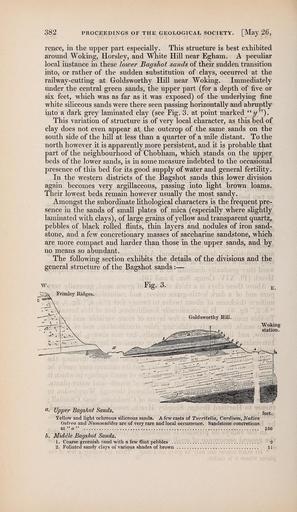MAKE A MEME
View Large Image

| View Original: | The_Quarterly_journal_of_the_Geological_Society_of_London_(13206282554).jpg (1199x2069) | |||
| Download: | Original | Medium | Small | Thumb |
| Courtesy of: | commons.wikimedia.org | More Like This | ||
| Keywords: The Quarterly journal of the Geological Society of London (13206282554).jpg 382 <br> PROCEEDINGS OF THE GEOLOGICAL SOCIETY May 26 <br> rence in the upper part especially This structure is best exhibited <br> around Woking Horsley and White Hill near Egham A peculiar <br> local instance in these lower Bagshot sands of their sudden transition <br> into or rather of the sudden substitution of clays occurred at the <br> railway-cutting at Goldsworthy Hill near Woking Immediately <br> under the central green sands the upper part for a depth of five or <br> six feet which was as far as it was exposed of the underlying fine <br> white siliceous sands were there seen passing horizontally and abruptly <br> into a dark grey laminated clay see Fig 3 at point marked 2/ ' <br> This variation of structure is of very local character as this bed of <br> clay does not even appear at the outcrop of the same sands on the <br> south side of the hill at less than a quarter of a mile distant To the <br> north however it is apparently more persistent and it is probable that <br> part of the neighbourhood of Chobham which stands on the upper <br> beds of the lower sands is in some measure indebted to the occasional <br> presence of this bed for its good supply of water and general fertility <br> In the western districts of the Bagshot sands this lower division <br> again becomes very argillaceous passing into light brown loams <br> Their lowest beds remain however usually the most sandy <br> Amongst the subordinate lithological characters is the frequent pre- <br> sence in the sands of small plates of mica especially where slightly <br> laminated with clays of large grains of yellow and transparent quartz <br> pebbles of black rolled flints thin layers and nodules of iron sand- <br> stone and a few concretionary masses of saccharine sandstone which <br> are more compact and harder than those in the upper sands and by <br> no means so abundant <br> The following section exhibits the details of the divisions and the <br> general structure of the Bagshot sands ” <br> Fig 3 <br> tt- Upper Bagshot Sands ieet- <br> Yellow and light ochreous siliceous sands A few casts of Turritella Cardium Natica <br> Ostrea and Nummulites are of very rare and local occurrence Sandstone concretions <br> at o 150 <br> b Middle Bagshot Sands <br> 1 Coarse greenish sand with a few flint pebbles 2 <br> 2 Foliated sandy clays of various shades of brown 11 36933143 113687 51125 Page 382 Text v 3 http //www biodiversitylibrary org/page/36933143 1847 Geological Society of London NameFound Cardium NameConfirmed Cardium EOLID 50301 NameBankID 2693257 NameFound Natica NameConfirmed Natica EOLID 58662 NameBankID 2684906 NameFound Nummulites NameConfirmed Nummulites EOLID 6817785 NameBankID 3399048 NameFound Ostrea NameConfirmed Ostrea EOLID 10719983 NameBankID 2692450 NameFound Turritella NameConfirmed Turritella EOLID 52187 NameBankID 2683895 Biodiversity Heritage Library The Quarterly journal of the Geological Society of London v 3 1847 Geology Periodicals Smithsonian Libraries bhl page 36933143 dc identifier http //biodiversitylibrary org/page/36933143 smithsonian libraries Information field Flickr posted date ISOdate 2014-03-17 Check categories 2015 August 26 CC-BY-2 0 BioDivLibrary https //flickr com/photos/61021753 N02/13206282554 2015-08-26 12 56 13 cc-by-2 0 PD-old-70-1923 The Quarterly journal of the Geological Society of London 1847 Photos uploaded from Flickr by Fæ using a script | ||||